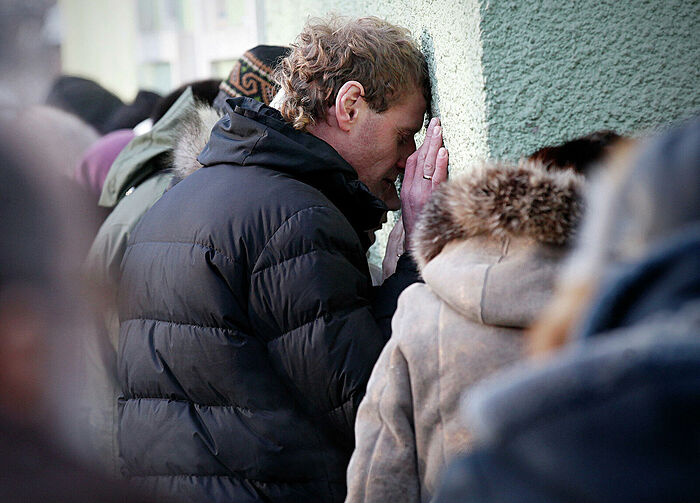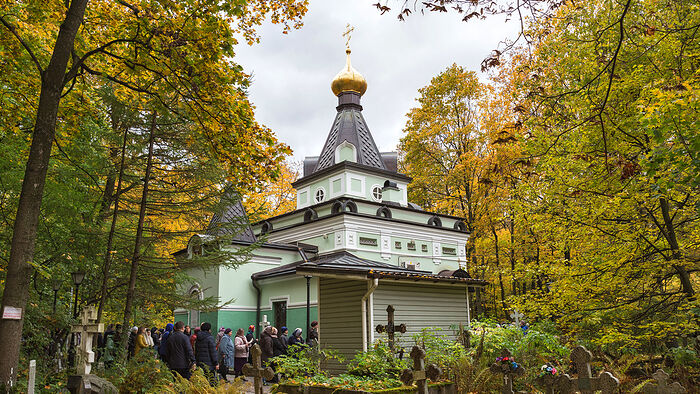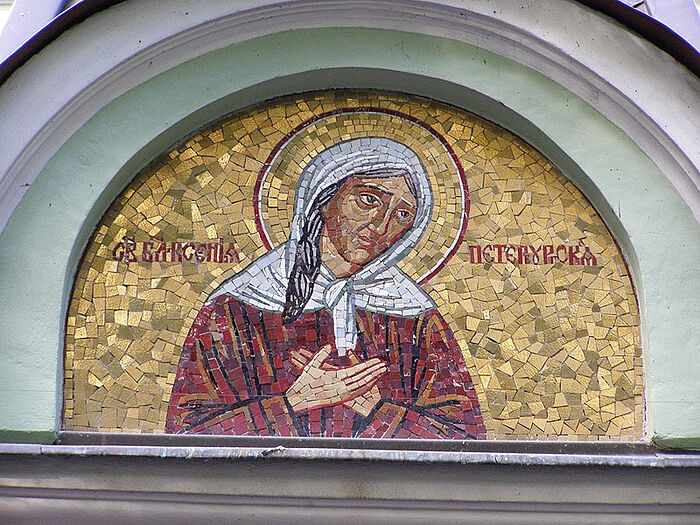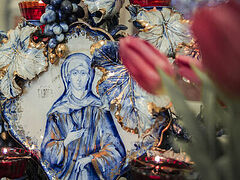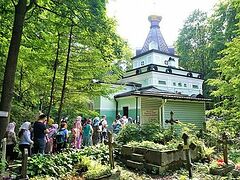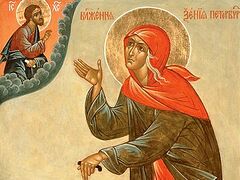Outside the train window, flickering by are fields, slopes, half-stops, and hamlets with tilting wooden huts and sad-looking cemetery churches with wooden cross blackened by the rain; Russia flickers by the window…
The psychology of a foreign tourist rushing to collect impressions can never understand what it is that those who love Russia love. The soul has to respond. Recall the words of Nikolai Rylenkov:
It’s not enough to see it,
You have to take a closer look,
For bright love
To fill your heart…
It’s all true—to hear, look closer, understand, and… to love—to love forever, to pain of heart!
The closer Russia gets to St. Petersburg, the more it is transformed in both my consciousness and my soul. It always feels like a majestic, sovereign symbol even from a distance, awe-inspiring in its historical grandeur and shining in an aureole of divine trials, but I was filled with special feeling—I was riding with prayer to St. Xenia of Petersburg.
The Smolensk Cemetery
The autumn day was so overcast that even noonday seemed like thickening dusk, but it didn’t take long to find the Smolensk Cemetery—the gates could be seen from afar, its semicircular yellow arches truly marked a window to another world.
The vanity of the big city remaining outside the brick walls immediately lost my attention—here, on this island of eternal rest, you involuntary focus upon the soul’s trembling and feelings, thoughts emerging on life and death, spiritual memory that connects generations, and the vainness of any attempt by this world to find a material measure for the value of human life…
Walking past the crosses and gravestones with crumbling corners and half-erased inscriptions, I am compelled to slacken my steps and contemplate those who have found rest on the shores of the Smolenka River. It is considered that precisely here, somewhere amidst the centuries-old trees, is buried Arina Rodionovna Yakovleva—Alexander Pushkin’s nanny1 (a memorial plaque at the cemetery entrance testifies to this, although the grave is now lost).
The road fortified by red brick leads from the cemetery gates to the sky-blue church dedicated to the Smolensk icon of the Mother of God, also called the Hodigitria icon. The Mother of God will be the Way-Shower to the Kingdom of Heaven for those who strive to live according to God’s laws. They say that Blessed Xenia herself helped to build this church, secretly from others, carrying heavy bricks up the scaffolding by night.
Not far from the Smolensk Church, on the narrow Blok road, are the famous “Beketov” maple trees growing at the base of what was the grave of poet Alexander Blok before his remains were reburied on the Literati Bridges.
Pilgrims who walk to the chapel of St. Xenia of Petersburg bow deeply as they pass by the grave with a white wrought-iron cross—here is buried Anna the fool-for-Christ, who lived in the nineteenth century and possessed the gift of clairvoyance. They say that not long before her death, Blessed Anna came to the Smolensk Cemetery, spread a scarf on the ground, and asked the priest to serve a Pannikhida for slave of God Anna. She was soon to be buried on that spot…
Against the background of a grey sky is seen a black, marble cross with the epitaph, “Grandfather of Russian romance”, N. A. Titov. A little further away is a white slab with an angel in bas relief, the memorial gravestone of the famous archeologist A. V. Tischenko. A marble sarcophagus with angels sculpted at the corners rises grandly over all—this is the gravestone of the wife of Count A. N. Mordvinov…
A thin, aged woman in glasses—one of those they call a “real Peterburger”, carefully adjusting the artificial flower wreath on one of the gravestones, unobtrusively told me an interesting story:
This is the family plot of the Antonovs, and Ivan Ivanovich Antonov, whose grave I’m tidying, was the church warden of the Smolensk Church and adopted son of Prascovia Antonova, who was unable to have her own children. One day, St. Xenia of Petersburg, whose miraculous chapel is located right nearby, came to Prascovia Antonova and said, “You are sitting here darning socks, and you don’t even know that God has sent you a son.” And she told her to drop everything and run to the cemetery. Prascovia was quite bemused, but she went where Xeniushka told her to go. Not far from the cemetery, right before Prascovia’s eyes, a young pregnant woman fell under a carriage horse and after giving birth right on the bridge, passed away. And since the poor girl had no relatives, Prascovia took the boy in and raised him in a Christian spirit.
Then turning her face toward the chapel of St. Xenia of Petersburg, the elderly lady crossed herself and added:
“Everyone loves Xeniushka. She helped everyone and still helps! The main thing is to believe in her help.”
Chapel of Blessed Xenia of Petersburg
There is a special grace by the chapel. No one here hides their tears. This is it—the final resting place of Holy Blessed Xenia…
It’s full of people, like on the central square of a city, but it’s amazingly quiet—only now and then does the soft singing of pilgrims walking around the chapel break out, as part of an independent “cross procession”.
“We magnify, we magnify thee, our Holy Blessed Mother Xenia, and we honor thy holy memory. For thou doest pray for us to Christ our God.”
The entire chapel is fill with flowers. In the bouquets are notes with prayerful requests. Many of those praying, pressing their foreheads to the chapel walls, weep over their sorrows and ask for help.
It is known that the chapel of St. Xenia of Petersburg was built on parishioners’ donations only in 1902, but before that time there was a small mound on her grave from which people who came there to pray would often take a little earth, and so the mound gradually began to disappear. A new mound on the grave met the same fate. A stone slab was installed. But even this stone slab was little-by-little chipped away by the faithful. Then it was decided to erect a chapel over the grave of Blessed Xenia.
What didn’t this chapel go through: During the war it warehoused bottles from fuels and lubricants; the marble slabs were dismantled from the grave cover, the church utensils stolen, and the icons burned. After the war the city authorities tried to install workshops here—first for shoemaking, then for sculpture… The boarded-up chapel, surrounded on all sides by an impenetrable fence, stood for a long time in desolation—but that did not prevent the multitudes of pilgrims from bringing their woes to Xeniushka and praying for her help. The entire wooden fence was always stuffed with notes containing prayers and words of gratitude. Only in 1984 was the chapel given over to the community of the Smolensk Church, and in 1988, Blessed Xenia was canonized [by the Moscow Patriarchate] and numbered among the saints of the Russian Orthodox Church.
Blessed Xenia (Xenia Grigorievna Petrova) lived in approximately the second half of the eighteenth century. In shock from her husband’s sudden death without repentance, Blessed Xenia consciously took upon herself the great ascetic labor of “foolishness-for-Christ”, renouncing not only material possessions, but even her own name—dressed in her husband’s clothes, the poor woman announced to her perplexed relatives that “Xeniushka died, but Andrei Feodorovich is alive.” Bringing her own rational mind as a sacrifice to God, Xenia resolved by this to bring down the Savior’s mercy for her beloved spouse.
The blessed one’s life was filled with wandering and prayers
She gave all the possession she inherited away to the poor, and began her wandering around Petersburg, enduring cold, heat, and want… With her great meekness and allegorical conversations the blessed one aroused in wicked people, especially in street urchins, the desire to mock the poor woman—they taunted her and threw stones and dirt at her. Blessed Xenia always bore it without complaint.
Little-by-little, people grew accustomed to the blessed one’s eccentricities. For her kindness and meekness people began to offer her warm clothes and money, but St. Xenia always refused to take off her pitiful rags and accept these alms. From good people she would only accept the “tsar on the horse” (kopecks with the image of a horse and rider) but would immediately give these kopecks to other poor people like herself.
During the day, Blessed Xenia wandered around the city, and at night she went out into the field and prayed on bended knee till dawn, making prostrations in all four directions.
People soon began to notice that the “crazy” words of Blessed Xenia were filled with deep meaning, that she had the gift of clairvoyance and healing, and if she would accept something from a merchant at the market, that day would be profitable for him. She especially had the gift of helping the formation of happy marriages.
To St. Xenia for help
The miracles for which the saint had become famous continued even after her death—by the prayers of Holy Blessed Xenia, healings from sicknesses began taking place, and cherished desires of the heart began to come true. Pilgrims from all over the world come to St. Xenia. And today, bending their knees before the white marble grave covering, they come to receive consolation in their sorrows and help in their good intentions, whispering: “Xeniushka, help!”
The ascetic labor of foolishness-for-Christ is unfathomable to the mind. And only the heart is capable of understanding the words of the evangelist Luke: For whosoever exalteth himself shall be abased; and he that humbleth himself shall be exalted (Lk. 14:11).

